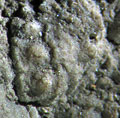Unfortunately, this taxon remains too poorly known to be classified at any level other than Cidaroida. Lambert & Thiery (1910, p. 127) described the tubercles as imperforate, but they are clearly perforate in Lambert\'s material. The spines are similar in form to those of \'Miocidaris\' verneuiliana, which is therefore provisionally included here. Smith & Hollingworth (1990), following Bather (1909) synonymized E. keyserlingi (Geinitz) and E. verneuiliana (King), because poor knowledge of the former precluded their definitive differentiation.
\'Miocidaris\' connorsi Kier, 1965, from the Permian of the USA has interambulacral plates that are not obviously imbricate and may belong here. It differs in having very sparsely tuberculate interradial zones, and more elongate spines.
Lambert & Thiery, 1910, p. 128 included one other species when erecting this genus, but this is Triadotiaris grandaevus a very different form.
The material illustrated here is the only specimen of this species in the Lambert collection, and presumably was what he based this genus on.
Lambert, J. 1899. Revue critique de Paleozoologie 3, p. 82.
Lambert, J. 1900. Etude sur quelques echinides de l'Infra-Lias et du Lias. Bulletin de la Societe des Sciences historiques et naturelles de l\'Yonne 52 [for 1899], 3-57.
Lambert, J. & Thiery, P. 1909-1925. Essai de nomenclature raisonnee des echinides. Chaumont, Ferriere.

